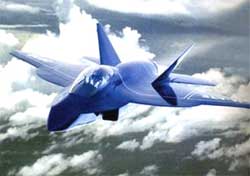|
Zhukovsky, Moscow Region: Russia's fifth-generation fighter planes, being developed by the Sukhoi design bureau in collaboration with India's Hindustan Aeronautic Ltd (HAL), is set to start flight trials in November, the Russian air force chief said Thursday. He also revealed that the fighters' engine development programme had run into some problems. Speaking at the MAKS air show outside Moscow, Col Gen Alexander Zelin said: "For the time being, the aircraft will use Saturn engines. There are problems, I admit, but research is continuing."  The T-50 Advanced Frontline Aviation Complex (PAK-FA), going by the Russian designation of the 5th Gen fighter, is intended to replace the Russian air force's fourth-generation fighters, namely, the Su-27 Flanker and the MiG-29 Fulcrum. The T-50 Advanced Frontline Aviation Complex (PAK-FA), going by the Russian designation of the 5th Gen fighter, is intended to replace the Russian air force's fourth-generation fighters, namely, the Su-27 Flanker and the MiG-29 Fulcrum.
The PAK-FA will also be inducted into the Indian Air Force as a two-seater version, compared to the Russian air force's single-seat version, and it is the Russian version that is due to commence trials later in the year. As the original Sukhoi design was not intended to incorporate a two-seater, the design bureau, along with HAL, is now working on strengthening the aircraft's structure so that it can carry increased weight. Earlier, in May, the Russian air force commander had indicated that three T-50 airframes had already been built, with at least one of these, very likely, a static fatigue test rig. Now, the Itar-Tass news agency quotes Gen Zelin as saying that the second prototype fighter jet was undergoing ''field trials.'' It is not clear what processes it is referring to when it says ''field trials,'' but very likely it is referring to land tests. All three prototypes have been built for land tests and a new one for aerial flights is on its way. Gen Zelin has reiterated time and again that the 5th-generation fighter jet will see its maiden flight later this year, ''in November, or probably in December.'' This is a subtle shift from the September-October period bandied about earlier. Deputy prime minister, Sergei Ivanov, had laid down a fiat in January this year that come what may the fifth-generation fighter jets must start trials this year and be in use by the air force by 2015. T-50 PAK-FA
The aircraft is designed to feature a long combat radius, supersonic cruise speed, low radar cross section, super-manoeuvrability, and the capability for short takeoffs and landings. It is expected to have a normal take-off weight of 20 tons, which is smack in between the average normal take-off weight of the two adversary, 5th Gen American fighters - the F-35 JSF (17.2 tons) and the F-22 (24 tons). The new fighter is expected to have a traditional wing form, though Russian experts say that the experience gathered as a result of Berkut's test flights will be taken in consideration when designing the fighter. The Berkut is the only aircraft in fighter history to have a Swept Forward Wing (SFW). It will be equipped with two AL-41F engines being developed by the Saturn scientific and industrial enterprise, an active phased array radar system developed by the Fazatron-NIIR Corporation and high-precision weapons. Interestingly, the new fighter is being sought to be developed from concept to a prototype series in less than 9 years. Historically, fourth and fifth generation fighters have not been created in less than 15 years. It is likely that the problems being referred to by Gen Zelin in the development of the engine may be more finance-related than technical. The Russian government had promised to allocate $1.5 billion for the PAK-FA through 2010. It is not known if it has kept to its promise. Completion of the AL-41F engine programme, according to Rosaviakosmos officials was dependent on cash flows of between $600-800 million. These figures are from tleast two years back, even before prices of resource materials and services skyrocketed around the world before the global crash. It is not evident if the Russian government has stuck to its promise to make adequate resources available. Russian sources have said an improved version of the AL-31F will be used on the prototypes, though these engines have been designed for aircraft heavier than the PAK-FA.
|